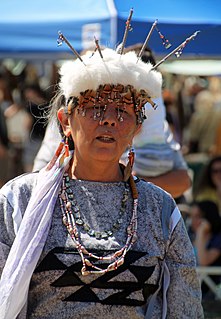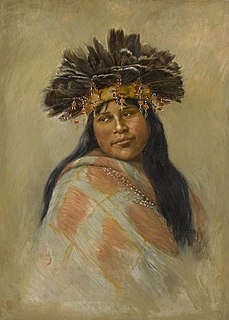
California is a state in the Pacific Region of the United States. With 39.6 million residents, California is the most populous U.S. state and the third-largest by area. The state capital is Sacramento. The Greater Los Angeles Area and the San Francisco Bay Area are the nation's second and fifth most populous urban regions, with 18.7 million and 8.8 million residents respectively. Los Angeles is California's most populous city, and the country's second most populous, after New York City. California also has the nation's most populous county, Los Angeles County, and its largest county by area, San Bernardino County. The City and County of San Francisco is both the country's second-most densely populated major city after New York City and the fifth-most densely populated county, behind only four of the five New York City boroughs.

The Pomo are an indigenous people of California. The historic Pomo territory in northern California was large, bordered by the Pacific Coast to the west, extending inland to Clear Lake, and mainly between Cleone and Duncans Point. One small group, the Northeastern Pomo of the Stonyford vicinity of Colusa County, was separated from the core Pomo area by lands inhabited by Yuki and Wintuan speakers.

The Hokan language family is a hypothetical grouping of a dozen small language families that were spoken mainly in California, Arizona and Baja California. In over a century since the "Hokan" hypothesis was first proposed by Roland B. Dixon and Alfred L. Kroeber, and further elaborated by Edward Sapir, little additional evidence has been found that these families were related to each other. Although some Hokan families may indeed be related, especially in northern California, few linguists today expect Hokan as a whole to prove to be valid.
The Dené people are an aboriginal group of First Nations who inhabit the northern boreal and Arctic regions of Canada. The Dené speak Northern Athabaskan languages. Dené is the common Athabaskan word for "people". The term "Dené" has two usages. More commonly, it is used narrowly to refer to the Athabaskan speakers of the Northwest Territories and Nunavut in Canada, especially including the Chipewyan (Denesuline), Tlicho (Dogrib), Yellowknives (T'atsaot'ine), Slavey, and Sahtu. But it is sometimes also used to refer to all Northern Athabaskan speakers, who are spread in a wide range all across Alaska and northern Canada. Note that Dené never includes the Pacific Coast Athabaskan or Southern Athabaskan speakers in the continental U.S., despite the fact that the term is used to denote the Athabaskan languages as a whole. The Southern Athabaskan speakers do, however, refer to themselves with similar words: Diné (Navajo) and Indé (Apache).

Chumashan is a family of languages that were spoken on the southern California coast by Native American Chumash people, from the Coastal plains and valleys of San Luis Obispo to Malibu, neighboring inland and Transverse Ranges valleys and canyons east to bordering the San Joaquin Valley, to three adjacent Channel Islands: San Miguel, Santa Rosa, and Santa Cruz.
Pacific Coast Athabaskan is a geographical and possibly genealogical grouping of the Athabaskan language family.

The Round Valley Indian Reservation is a federally recognized Indian reservation lying primarily in northern Mendocino County, California, United States. A small part of it extends northward into southern Trinity County. The total land area, including off-reservation trust land, is 93.939 km². More than two-thirds of this area is off-reservation trust land, including about 405 acres (1.64 km2) in the community of Covelo. The total resident population as of the 2000 census was 300 persons, of whom 99 lived in Covelo.
The Mendocino Range is one of several coastal mountain ranges which compose the Pacific Coast Range. This massive range of coastal mountains was formed during a period of coastal orogeny, millions of years ago. The Mendocino Range is a component of the California Coast Ranges of California. The Klamath Range is north of this region, and the Cascade Range runs to the northeast.
Kato traditional narratives include myths, legends, tales, and oral histories preserved by the Kato (Cahto) people of the Eel River basin of northwestern California.
California is the most populated U.S. state, with an estimated population of 39.497 million as of 2017. It has people from a wide variety of ethnic, racial, national, and religious backgrounds.
Tilly is a former settlement in Mendocino County, California. It was located 9 miles (14 km) west of Cahto.
A canto is the principal form of division in a long poem. It may also refer to:

Central Pomo is a moribund Pomoan language spoken in Northern California. Pre-contact speakers of all the Pomoan languages have been estimated at 8,000 altogether. This estimation was from the American anthropologist Alfred Kroeber.
USS Cahto was a harbour tug of the United States Navy.
Kato or Katō may refer to:

The Indigenous peoples of California are the indigenous inhabitants who have lived or currently live in the geographic area within the current boundaries of California before and after the arrival of Europeans. With over forty groups seeking to be federally recognized tribes, California has the second largest Native American population in the United States. The California cultural area does not conform exactly to the state of California's boundaries. Many tribes on the eastern border with Nevada are classified as Great Basin tribes, and some tribes on the Oregon border are classified as Plateau tribes. Tribes in Baja California who do not cross into California are classified as Indigenous peoples of Mexico.

The South Fork Eel River Wilderness is a 12,868-acre (5,207 ha) wilderness area located in Mendocino County, California. The wilderness was added to the National Wilderness Preservation System when the United States Congress passed the Northern California Coastal Wild Heritage Wilderness Act in 2006. The Department of the Interior's Bureau of Land Management (BLM) is the agency in charge.








